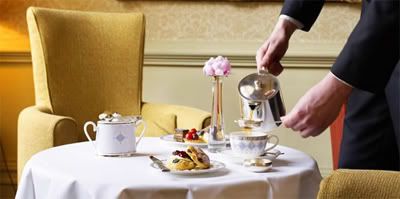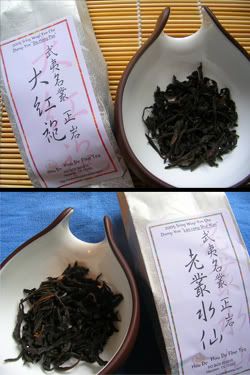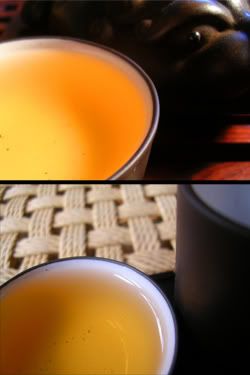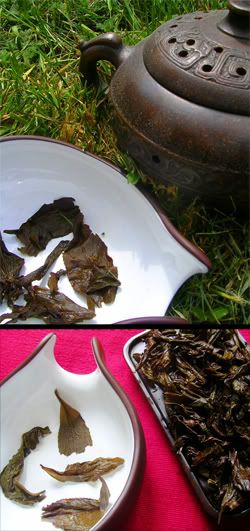
While not likely to find anything more adventurous than a somewhat greener Darjeeling, they do serve a very pleasant Lapsang Souchong [Zhengshan Xiaozhong], which is a good grade of leaf, lightly smoked with pine. It makes a refreshing change to the smoke-stack lapsang tea that is usually on offer in England. Today, we found out that this rather enjoyable leaf comes from Twinings, of all places - who knew that they could actually produce decent tea?
 Moving swiftly on, we cover the remaining two of the Sidamingcong [Four Great Famous Bush] yancha from Houde: the Dahongpao [Big Red Robe], and Laocong Shuixian [Old-bush Water-Sprite/Narcissus-Flower]. As before, both are designated "zhengyan", claimed to be from the central Wuyi area. As always, we'll take this under advisement and let our tastebuds make the decisions. Note that these are 2005 teas, whereas the previous pair were 2004.
Moving swiftly on, we cover the remaining two of the Sidamingcong [Four Great Famous Bush] yancha from Houde: the Dahongpao [Big Red Robe], and Laocong Shuixian [Old-bush Water-Sprite/Narcissus-Flower]. As before, both are designated "zhengyan", claimed to be from the central Wuyi area. As always, we'll take this under advisement and let our tastebuds make the decisions. Note that these are 2005 teas, whereas the previous pair were 2004.In the following, the Daohongpao and Shuixian will be A and B, respectively, and appear in upper and lower in photographs, respectively.
12cl nongxiang pot; Caledonian Springs @ 90C; 2 scoops; 1 rinse.
Dry leaves:
A:
Large 3-4cm twisted strips, all thoroughly roasted and suitably dark. "Very decent." A highly edible roast aroma!
B:
Similar to A, again with no small fragments - just plenty of long, twisted segments. A stable but rather quiet creamy, roast aroma.
 15s, 15s, 20s, 25s, 40s, 60s:
15s, 15s, 20s, 25s, 40s, 60s:A:
Orange soup with a green twist. A very sweet, constant aroma - very long in the wenxiangbei - that eventually becomes a muscavado sugar lengxiang. It really does hold on for a long time indeed, indicative of decent leaf endurance, we hope.
Very sour, but that's a good thing for this tea. The roast is pleasant, and wonderfully understated - as discreet as a Randolph tea-waiter. The chaqi is fine: my cold limbs are flushed with warmth.
Later infusions see separation into the sour and roast constituents, and it becomes a little "green" in the throat. The huigan is energetic, and enduring.
B:
The rich, dark scent of molasses, from beidixiang to lengxiang. Rich orange soup.
The flavours are chocolate-like, almost powdery, reminiscent of a malted bed-time beverage. "A clear and wide flavour", which I find to be broad and open. It is, again, understated in its roast, which can only be a good thing, showing the gentlest of tea-sourness. A very comforting tea - perfect for a cold day, with a Bach violin sonata.
 Used leaves:
Used leaves:A:
Surprisingly green. These are smaller leaves than the 2004 pair from yesterday, perhaps indicative of a better grade. The oxidation in the chahe gives a pronounced peach aroma that was not present in the tasting session.
B:
Edge-oxidised, but quite green - indicative of that restraint in the roasting. Pleasant, hand-picked leaves of a generally small size.
Overall:
A:
This dahongpao is refined and elegant. It is not complex, being a smooth and consistent combination of sweet-sour tea with a fine roast. Happily, these zhengyan teas seem to have plenty of innate flavour that does not require a pungent, overbearing roast - much like the Lapsang Souchong from the hotel, in fact. Downhill after the second infusion.
B:
Malty, granular, slow, and rich, with the long aroma of molasses. This is a dark and sticky shuixian, to pair with the dry and noble dahongpao. Like its 2005 stablemate, this tea begins to show signs of age after the second infusion. The 2004 teas from yesterday had greater endurance.
In all, the Sidamingcong offer something different in each. It was an interesting learning experience, made easier by decent leaf - from the sweet and lighter pleasures of the baijiguan, to the straight-faced nutty roast of the Tieluohan; from the noble and simple sour-roast of the dahongpao, to the sticky molasses of the shuixian. Quite the pleasure.

5 comments:
Hi Hobbes,
I'm enjoying your back catalogue--picking out teas I've been enjoying myself and seeing what your opinion is! I certainly feel the same about the Bai Ji Guan and Tie Lo Han. If I'm not mistaken, though, isn't the fourth of the Sidamingcong Shui Jin Gui, NOT Shui Xian?
I've got some more fun reading ahead of me...
Elliot
Dear Elliot,
I'm very glad that you're enjoying the blog!
You're absolutely correct, the fourth is usually Shuijingui. I don't remember why this article was incorrect - thanks very much for pointing it out.
Toodlepip,
Hobbes
The lao cong SX has some wood and plums these days. The coating of the mouth is quite multiflavoredly delicious and long lasting.
Now there's a blast from the past - I wonder if I still have some of the sample remaining in my oft-unopened "wulong bag" of samples. :)
Toodlepip,
Hobbes
Now there's a blast from the past - I wonder if I still have some of the sample remaining in my oft-unopened "wulong bag" of samples. :)
Toodlepip,
Hobbes
Post a Comment